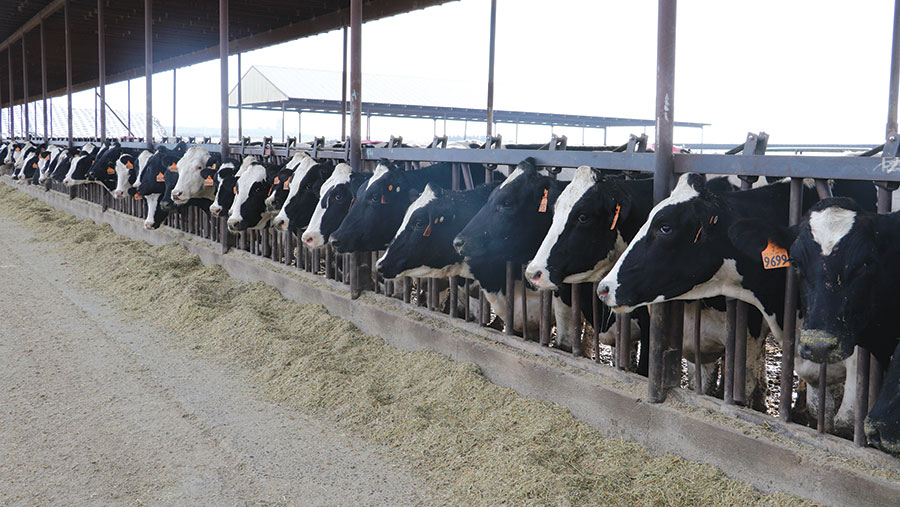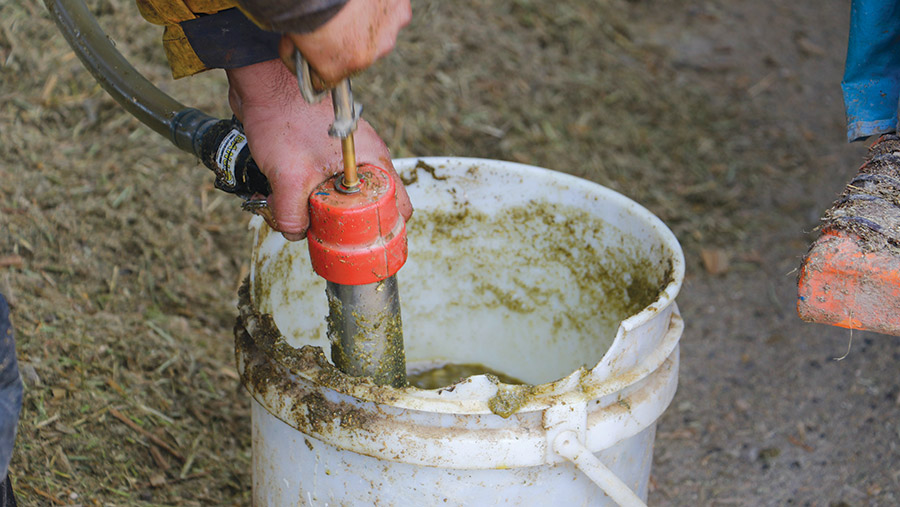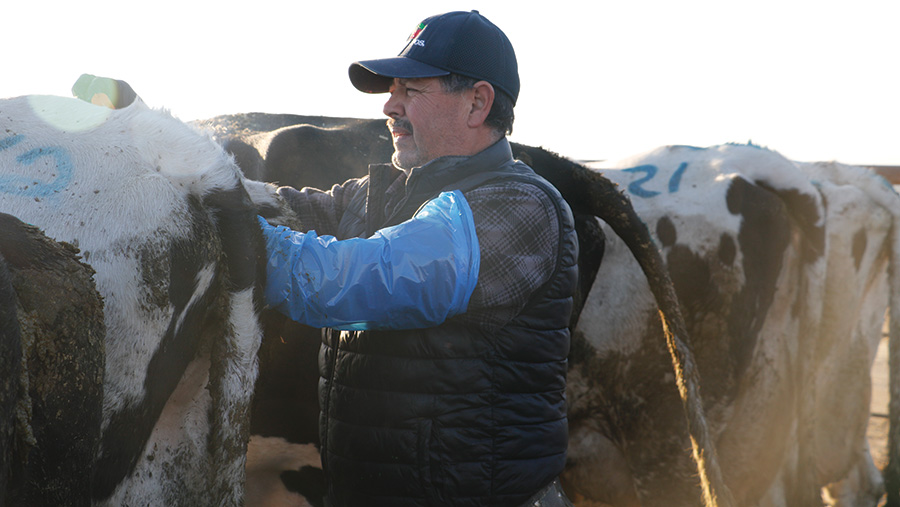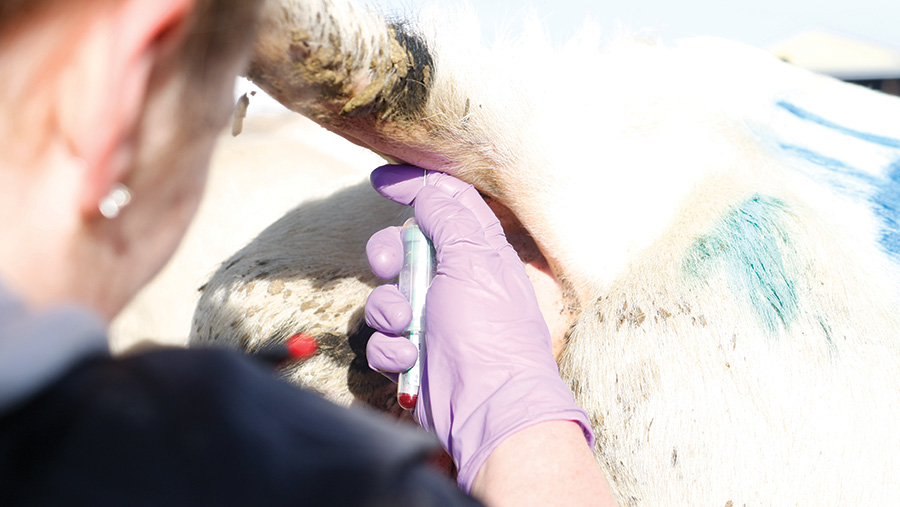6 fresh cow checks to prevent problems after calving

Pinpointing health issues early on in fresh cows, gives farmers a better chance of treating them successfully.
Scott Abbott from Dairy Vet Management, says: “The earlier you intervene, the more likely she [the cow] is to respond.
“The goal is to ensure cows make the transition and get maximum milk production and reproduction.”
Mr Abbott explains how to carry out simple fresh cow checks, which six key problems to look out for and how to treat them promptly.
See also: Step-by-step guide to avoiding losses at calving
Risk factors associated with problem fresh cows
- Long dry periods – more than 90 days
- High BCS (more than 3.25)
- Long lactations (aim to dry off at 225-231 DIM)
- Short time in the close-up period prior to calving (less than 14 days is an issue)
1. Digestive upset (leading to displaced abomasum and ketosis)
Feed intake is the biggest thing that will limit performance. Usually, producers will look for metritis, but digestive upset can account for more than 50% of problems in the fresh cow period, whereas, typically metritis accounts for 30%.
Targets
- Less than 10% of cows and less than 5% of heifers leaving the herd by 60 days in milk. Any more than that suggests you are failing your fresh cows
- Less than 10% positive for ketones
“We need to change our focus a little bit. We need to set the cow up so there is room for every cow to eat, including the weakest cow,” suggests Dr Abbott.
As a cow starts to calve, her feed intake will naturally decline, but her appetite should increase gradually afterwards.
The goal should be to acclimatise the cow to the milking ration and keep the rumen full to prevent metabolic disease.
What to look for
- Walk in front of the animal. Is she eating? Look to see if she has feed on her mouth
- Walk behind the animal: check her rumen fill. This is the area right behind the rib. Is it sunken or hollow?
- Look at her dung consistency
- Key is to look for animals that are different from others within the group
Advice on maximising intakes
- Space is critical: Provide 75cm linear space a cow or 85-90% of feed bunk capacity
- Provide 10cm linear water space a cow
- Give them 4.5m wide feed alley and 3.2m between cubicles
- Never feed forages longer than the width of the mouth to reduce sorting
- If possible, run a separate group of fresh cows and heifers for 20-25 days after calving (heifers should be given longer)
- Aim to feed 60% of the milking ration. For example, if your milking cows are eating 28kg DM then your fresh cows should be consuming 14-15kg DM
- Ensure there is plenty of feed – target 10% wasted that you can feed to other animals pre-and-post fresh (15 days each side). In the milking group, wastage should be reduced to 1-2%
Treatment
- Drench to keep the rumen full and prevent metabolic disease
- Use a 2m pipe to ensure the liquid passes to the stomach and not the lungs

2. Lameness
If a cow is lame, it is going to cause us problems because she will spend less time feeding and more time laying, says Dr Abbott.
What to look for
- Cows that are leaning on one side or arching their back, as this is a sign they are uncomfortable
Advice on preventing lameness
- Give cows a therapeutic trim two days before drying-off or as close to drying-off as you can to help reduce milk yield
- Foot-bath cows regularly to prevent digital dermatitis
Treatment
- Lift foot, diagnose condition and treat immediately.
3. Mastitis
Mastitis is an inflammatory reaction in the udder to mammary gland infections. It occurs when bacteria enter the quarter through the teat canal.
One or multiple quarters can be affected. Infected animals are more likely to be culled, lose body condition and are less likely to get pregnant quickly.
What to look for
- Uneven or swollen udder
- Heat
- Hardness
- Pain
- Milk has a watery appearance, flakes, clots or pus
Treatment protocols
- Milk fever: Down cows should be given calcium intravenously, but if the cow is standing, give them a calcium bolus or calcium propionate drench as this isn’t as toxic
- Ketosis: Administer propylene glycol
- Fat cows: Cows with a BCS higher than 3.25 at calving are at increased risk of metabolic disease. Give them calcium the day of calving and repeat the next day. Administer vitamin B12 to prevent fatty liver the day of calving up to day three. On day two, drench with propylene glycol for a minimum of three days
Advice on preventing mastitis
- Good drying-off technique, maintaining high levels of cleanliness at all times
- Always wear gloves
- Clean the front teats first when drying off but seal the back teats last to prevent contaminating teats with dirty forearms
- Ensure bedding is dry and clean
Treatment
- Intra-mammary antibiotic and anti-inflammatory to relieve pain
4. Pneumonia
Respiratory disease can cause reduced milk yield, weight loss and poor fertility.
What to look for
- A cow that is breathing faster than other cows – above 40 breaths per minute (check behind her ribs to watch for the rise and fall)
- High rectal temperature
- Coughing
- Nasal discharge
Prevention
- Good ventilation
- Vaccination
Treatment
- Antibiotics
- Anti-inflammatory
Tips on carrying out checks
- Note date of calving on each animal
- Check every animal every day until they leave the fresh cow pen. Walk front and back and mark up any issues
- Look at cow demeanour: Are their eyes sunken? Are they alert or less responsive?
- Carry out visual checks daily (rumen fill, dung consistency, breathing rate, lameness, mastitis and metritis and calving injuries)

- Take temperatures daily (more than 39.5C is high) on cows less than 12 days fresh and on problem cows more than 12 days fresh
- Take bloods from the tail and carry out ketone tests at day four to seven to assess for blood betahydroxybutrate (BHB) to identify ketosis. More than 1.2 millimoles is considered abnormal. Doing it early at day three means you can often miss ketosis because BHB won’t be high enough to show positive

- Recheck ketones on day 10
- If you have a large herd and it’s not possible to test every cow, test a group of about 20 animals
- If an animal isn’t performing, hold her back in the fresh group until she improves
5. Metritis
Metritis is caused by bacterial infection of the uterus and typically occurs in the first few days after calving.
What to look for
- Red and watery discharge (don’t get hung up on colour score cards)
- Temperature
- Always put your hand in the rectum when checking for discharge, because if you go in the vagina, you are more likely to introduce infection
Treatment
- Never wash out a dirty cow. You can introduce infection
- Treat with a course of antibiotics. For it to be effective, it must permeate the uterus so always ensure you give the right dose
- A common treatment a lot of people administer for retained placentas is prostaglandin, but it is not effective prior to 10 days in milk (DIM). This is because prostaglandin is produced by the uterus at calving and adding more does nothing
- Can give oxytocin to help with uterine contraction. Cows can become addicted so don’t give more than 2ml/day and halve the dose each day
6. Calving injuries
Tears and swelling can be caused by difficult calvings or large calves. Heifers can be particularly at risk because it’s their first time giving birth.
What to look for
- Swollen vulva
- Vagina may feel tight and lumpy
Treatment
- Start the animal on a course of antibiotics immediately
- Provide pain relief
Propylene glycol drenches
Should you give all fresh cows propylene glycol drenches after calving? Scott Abbott discusses below
Giving healthy fresh cows glycol straight after calving will have limited effect, as blood glucose levels are high after calving.
This is caused by the production of the hormone cortisone, which is released at calving.
In high-risk animals (high BCS), however, where fatty liver could be a risk, there is an argument for using glycol on day two, when blood glucose levels start dropping, along with B12 to block fat absorption.
In fact, using propylene glycol can have a detrimental effect because it can suppress appetite, so for this reason, and to avoid wasting money, only target it at higher-risk animals.
Scott Abbott is a vet and consultant, he works for Dairy Vet Management, based in Washington State, US, and is director of technical services at World Wide Sires.
World Wide Sires (WWS) also provides training through The Global Training Centre and offers management and reproductive training to people working within the dairy industry.
